Challenging life events can come crashing into our lives and turn our worlds upside down. But for some, those events can also provide opportunities to rediscover one’s creative path.
Having trained and worked as a doctor for much of her career, Caroline Nixon became the patient in her mid-50s. Her diagnosis forced early retirement for regular treatments. Ironically, those disruptions resulted in Caroline’s ability to return to her love of sewing. And slowly but surely, the patient would become a textile artist.
Early on, Caroline found a passion for printing and dyeing fabrics. But her health challenges prevented her from using chemical-based products. Caroline began foraging outdoors to discover what types of natural dyes surrounded her. As the saying goes, the rest is history.
Today, Caroline focuses on natural dyes, eco-printing, hand stitch and repurposing. She grows many of the dye plants herself, mingled among the veggies in her garden. And she is now a world-renowned expert on eco-printing and dyeing.
We’re delighted to share Caroline’s process and creative path, where you’ll learn about her infamous fish kettle, as well as techniques and tips on eco-printing. We promise you’ll be inspired to explore the eco-printing world.
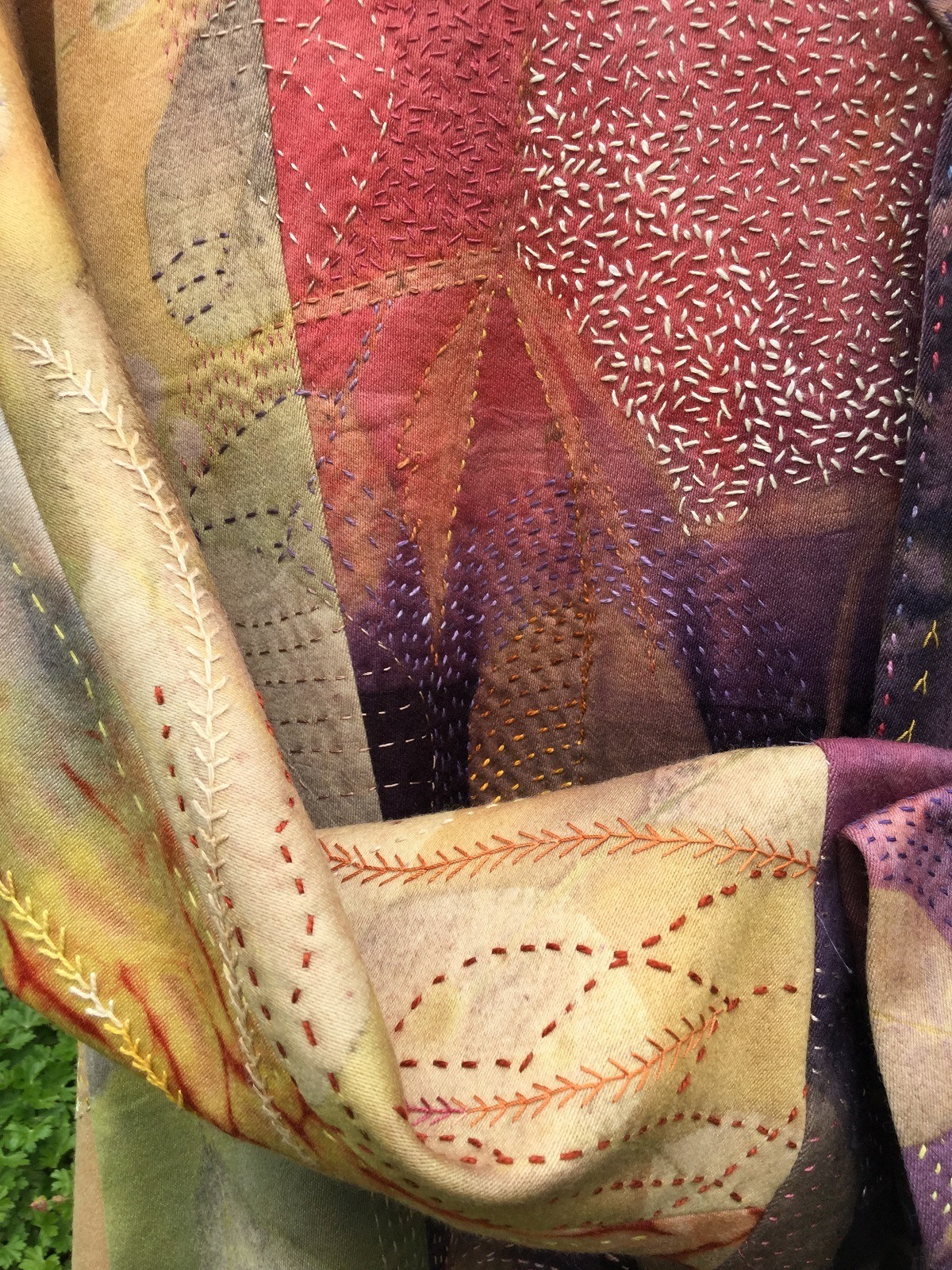
From doctor to artist
What initially attracted you to textiles as a medium?
Caroline Nixon: One of my earliest childhood memories is sitting with my beloved grandma learning how to hand sew, and later, to use her ancient treadle Singer sewing machine.
I also adored her big collection of vintage buttons kept in one of those large glass jars they used to have in sweet shops. For me, those buttons were more enticing than sweeties!
Sewing became my go-to activity when I wanted to relax, but it was some years before I realised it could also be an art form. That was the moment when a whole new and exciting world opened for me.
When I discovered the soft, harmonious colours of natural dyes and the photorealistic prints that could be obtained from leaves, I realised I had found my textile ‘home’.
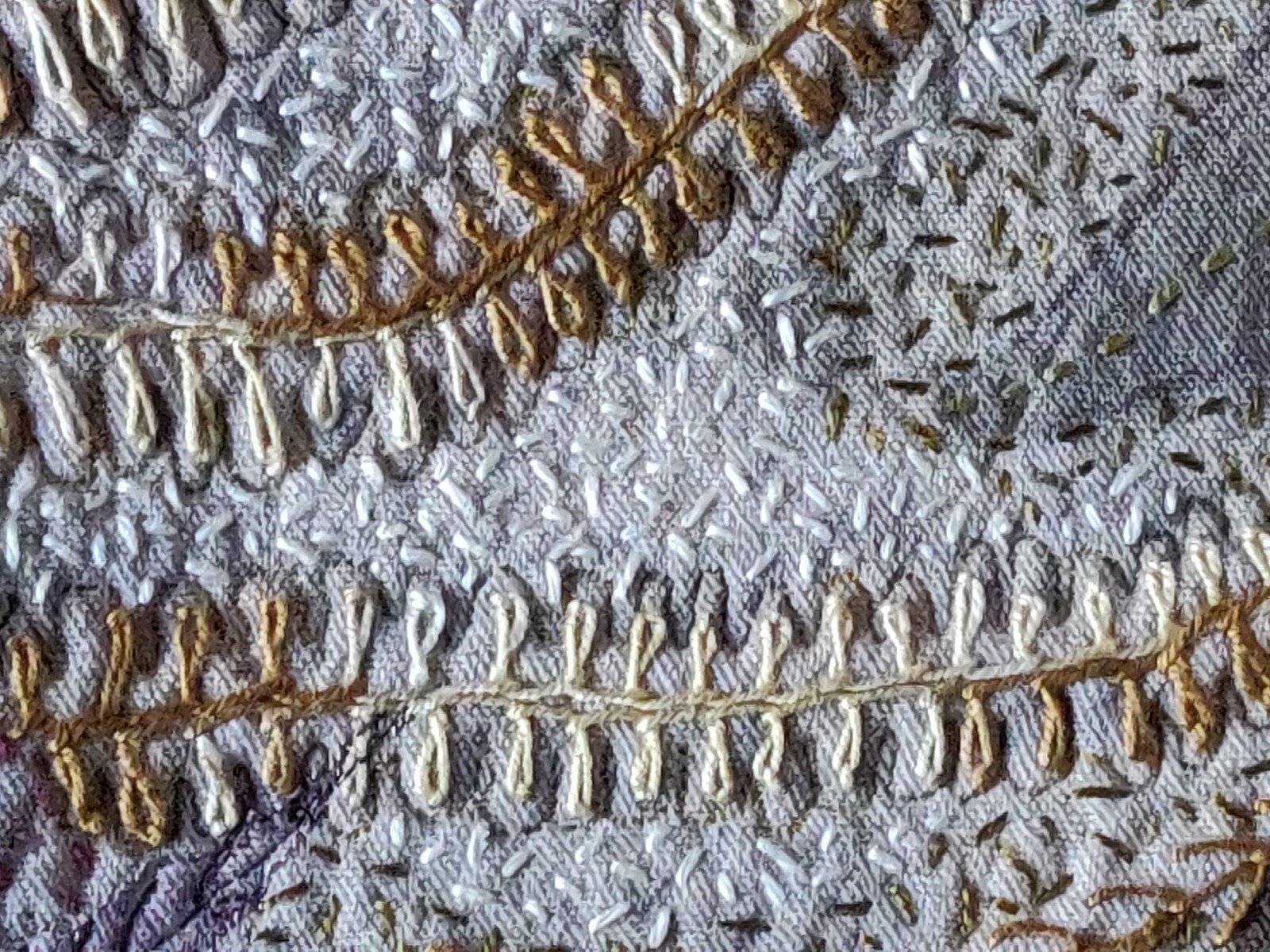
What or who were your early influences?
Most of my work comes from my own imagination and experimentation, but there are people who have been a big influence and inspiration to me.
A workshop with Angie Hughes on printing and embellishing velvet provided the lightbulb moment that sewing could produce something much more exciting than clothing.
Following that, books by Jan Beaney and Jean Littlejohn opened my eyes to the possibilities of colouring and patterning my own cloth for backgrounds on which to stitch.
In terms of eco printing, I am greatly influenced by Irit Dulman, whom I consider to be the world’s most talented eco printer.
My science background definitely influences me. Unexpected results are exciting, but I want to understand the ‘why’ as well as the ‘how.’ Exploring the science behind the art has helped me get reproducible and reliable colourfast results that still bear an element of serendipity and surprise.
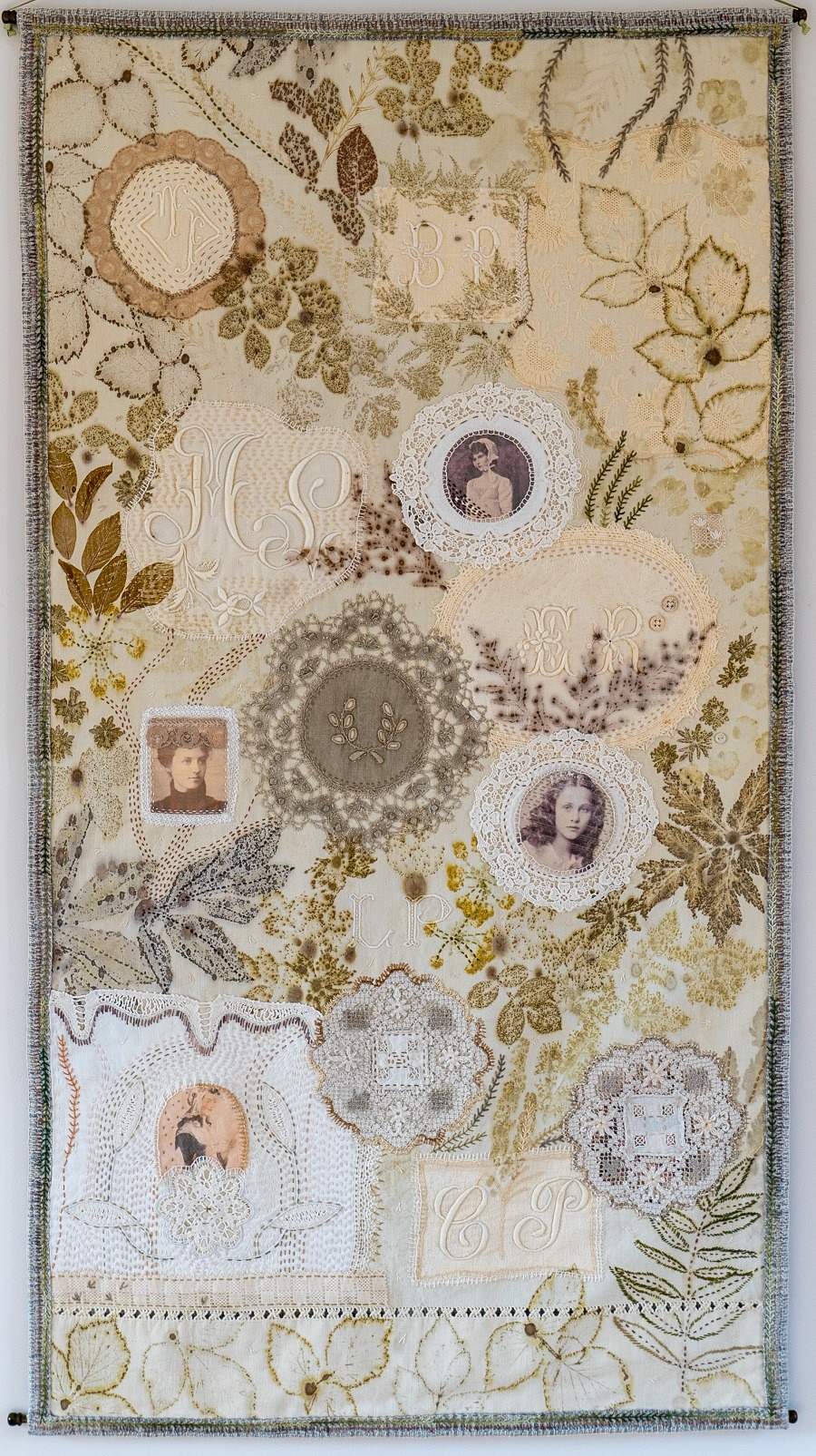
A natural approach
What was your route to becoming an artist?
A circuitous one!
I trained as a doctor and worked for the NHS (National Health Service) all my working life, complemented by interspersed periods of volunteer work in various parts of Asia. Unfortunately, when I became sick in my early 50s, I had to retire early on health grounds. Between treatments, I found myself with plenty of time to sew.
Working with textiles was my comfort and motivation during those times. But something felt wrong. I was trying to lead the healthiest possible lifestyle with nutritious foods and lots of fresh air, but using chemical and synthetic dyes did not fit in with those efforts.
I started to explore the possibilities of natural dyes and was immediately entranced by their subtle, harmonious colours. Then, quite by chance, I met Nicola Brown, a wonderful felter and eco printer. She generously shared her knowledge with me, opening up the exciting world of eco printing.
My last volunteer post abroad was in Bangladesh. There, I saw first-hand the harm done by the garment industry in terms of human exploitation and damage to the environment. That inspired me to work wherever possible with natural processes and to use repurposed and recycled textiles.
One of my greatest joys is rummaging in French flea markets for vintage linens, and I love to reuse them again by turning them into clothes, cushions or textile art.
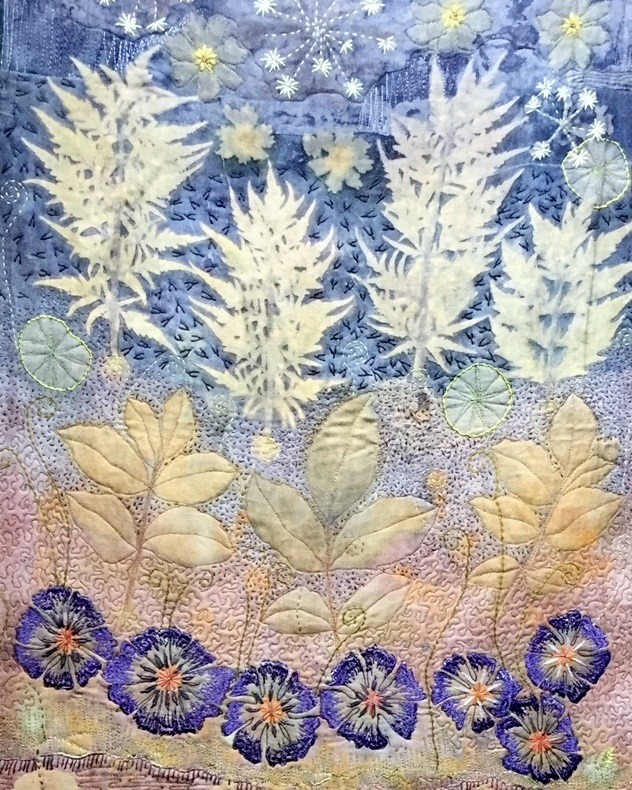
Fish kettles & found materials
Tell us about your eco printing process…
My work often starts with the planting of a seed, the taking of a cutting, foraging in the woods and hedgerows, or finding a new exciting leaf with which to experiment. Sometimes, I will be working to a specific brief. But more often than not, the leaves themselves tell me how they should be composed, which natural dyes will complement them, and which cloth will best accept their pigments.
The crucial elements for eco printing are heat, moisture and pressure. This is achieved by placing the leaves on the cloth, rolling tightly on a pole, and binding tightly with twine. Then everything is steamed in a pot of water to develop and set the colours.
As the seasons progress, the leaves change, so my favourite species to print with change during the year. Horse chestnut makes wonderful big dramatic prints in spring. Paeony and geranium are wonderful in summer. Maple and oak are special favourites in autumn, and in winter I move to the rich red prints of eucalyptus.
Eco printing is a process in which you need to commit quite early. Once the bundle is rolled and steaming in the pot, it’s too late to decide to just pop a couple more leaves into the bundle! So, once the leaves are laid out, that is often a moment for a long pause and reflection. I look to see if the composition is balanced and that the leaves are well-spaced and the right way up.
Colour and texture are applied with natural dyes, sometimes with shibori techniques. Many of the dyes I use are grown in my own garden. Weld, madder and dyer’s greenweed are favourites. I also buy natural dye extracts, including cochineal bugs from a women’s co-operative in Mexico and sappanwood from a sustainable plantation in India. Sometimes they are used first to give a coloured background, and sometimes they can be applied afterwards to modify the colours.
And what do you do with your printed cloths?
Once the fabric has been eco printed I hand stitch them, with no backing and no hoop. I have a lovely stash of threads collected in flea markets, charity shops and donated by friends. I also dye threads with natural dyes, often tossing them into the dye pot along with my fabric.
After that, I mount the work on a backing fabric if I am also going to add free machine embroidery. I have an old Bernina sewing machine. It weighs a ton, is built like a tank and it ploughs effortlessly through many layers of fabric. I also have a newer Bernina for making clothes, but for free machining, I usually reach for the trusty older model.
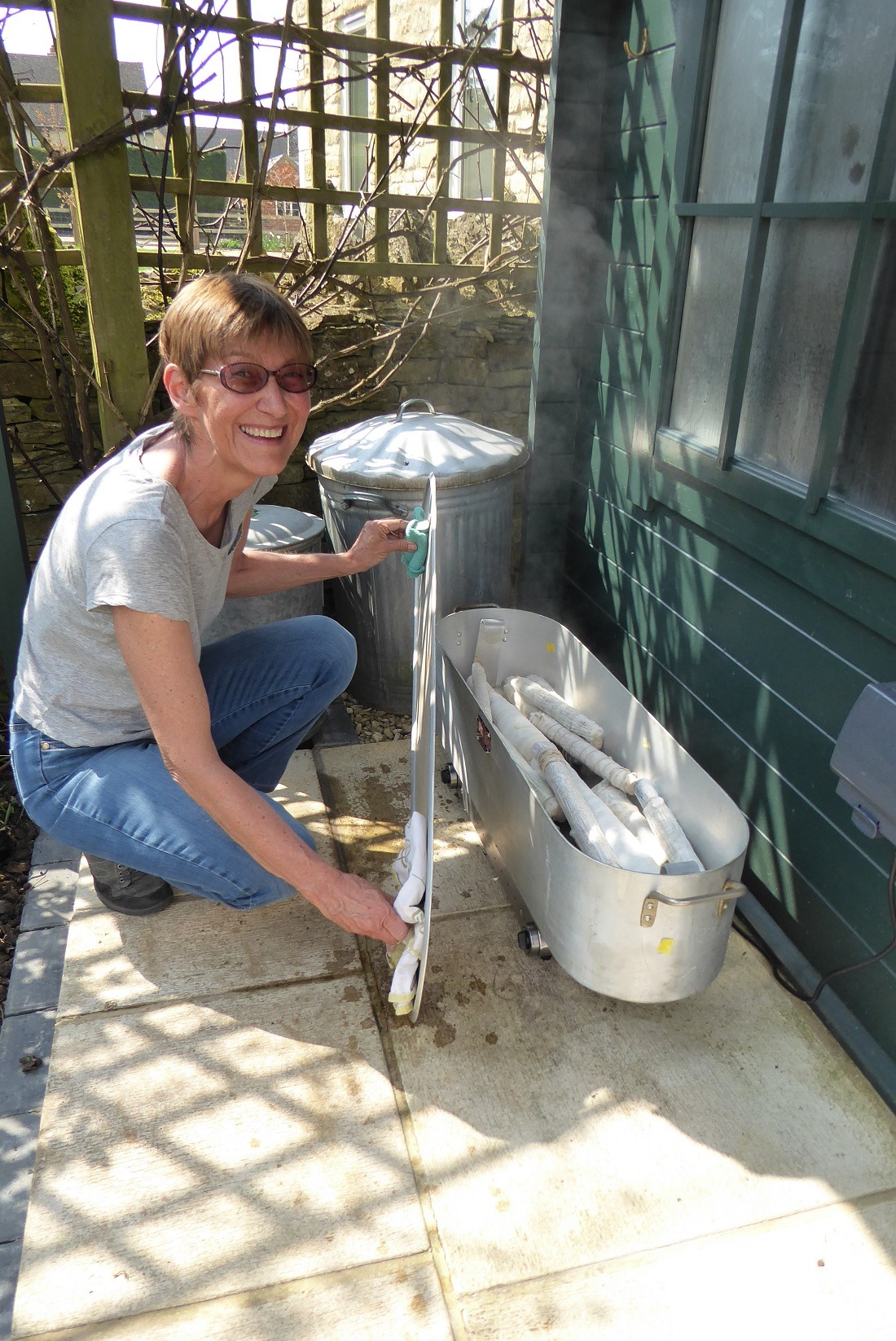
Tell us more about the tools you use…
My enormous fish kettle always gets a laugh, but I don’t want people to worry that they need a pot as big as that! I use it for workshops and for large commissions. And yes, I bought it at a French flea market.
I have a huge collection of pots and pans, donated by friends and bought in flea markets and charity shops. Preserving pans for jam making are a favourite. With some techniques, the metal of the pot will affect the colour of the prints. For example, copper pots can accentuate the greens.
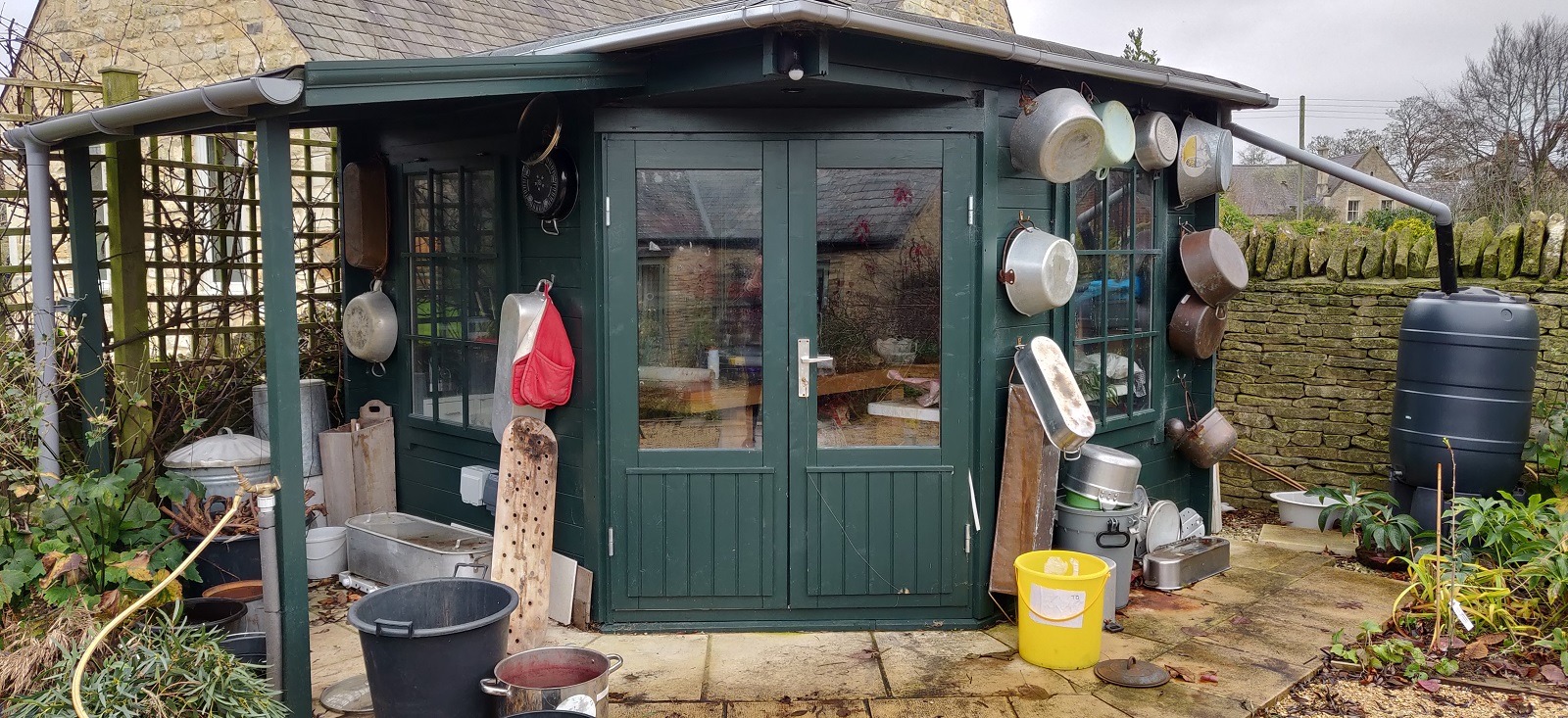
And where do you get your materials?
When it comes to choosing fabrics at flea markets, I always look for natural fibres. Vintage French linen bed sheets are a favourite, as well as preloved cashmere and lambswool sweaters from charity shops.
I also love incorporating lace and monograms and often wonder who made those delicate fabrics and what was her life like.
Anything bought second-hand goes straight into the washing machine and then is stored in a plastic bag until it is used and to help keep moths at bay. After boiling in the dye pot, though, Mr. Moth is gone for good!
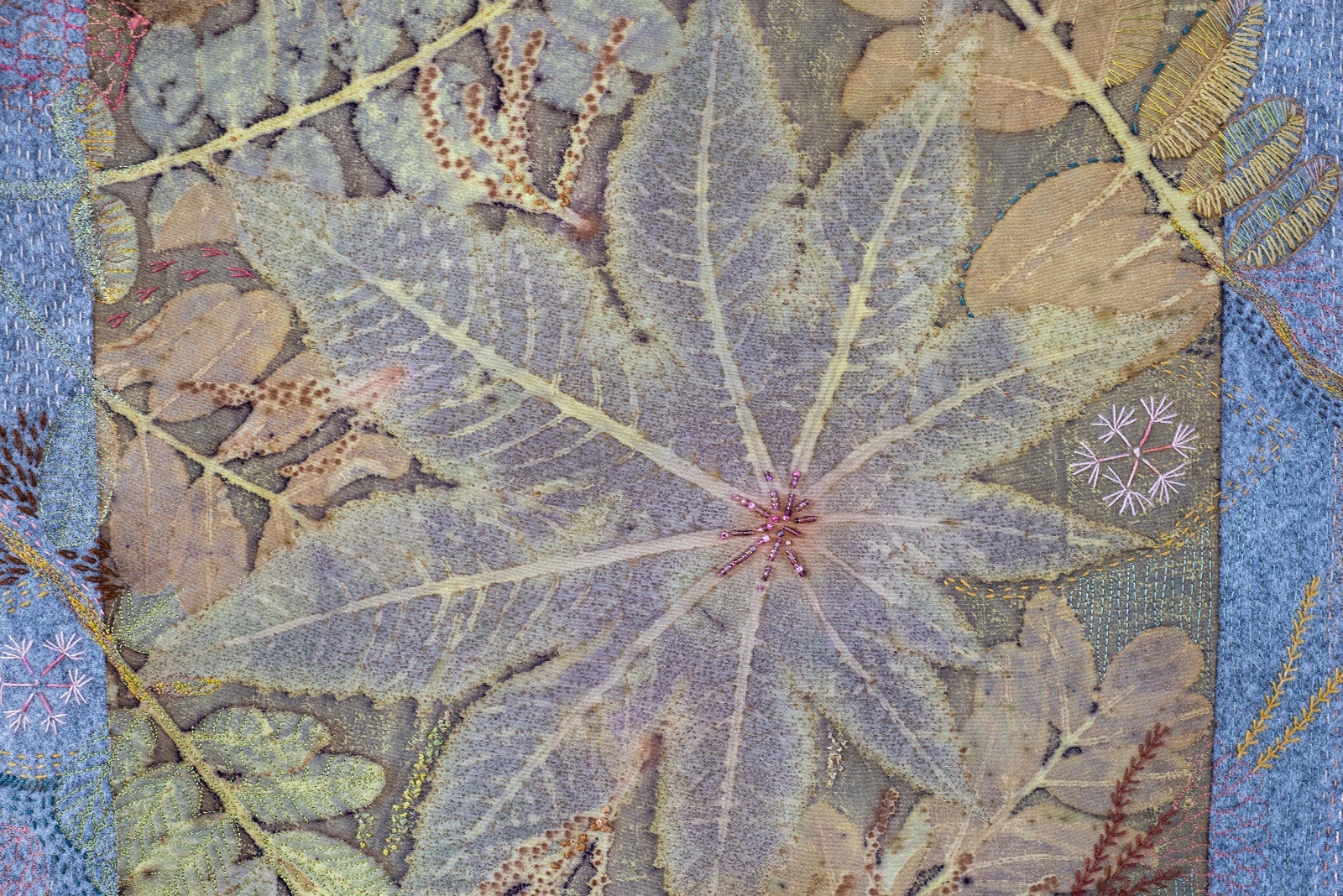
Leaves & networks
What currently inspires you?
I’m most inspired by the materials I use: the leaves, the dyes and the fabrics. They all have their own personality, and I love the challenge of working out how to maximise their potential. What could be more inspiring than to step out into the garden in early morning hours to being harvesting leaves for my work?
Other eco printers also greatly inspire me. We are a close-knit group and share information generously. It’s wonderful to see how people start with basically the same knowledge base and then evolve their own unique way of using it to produce incredibly varied work.
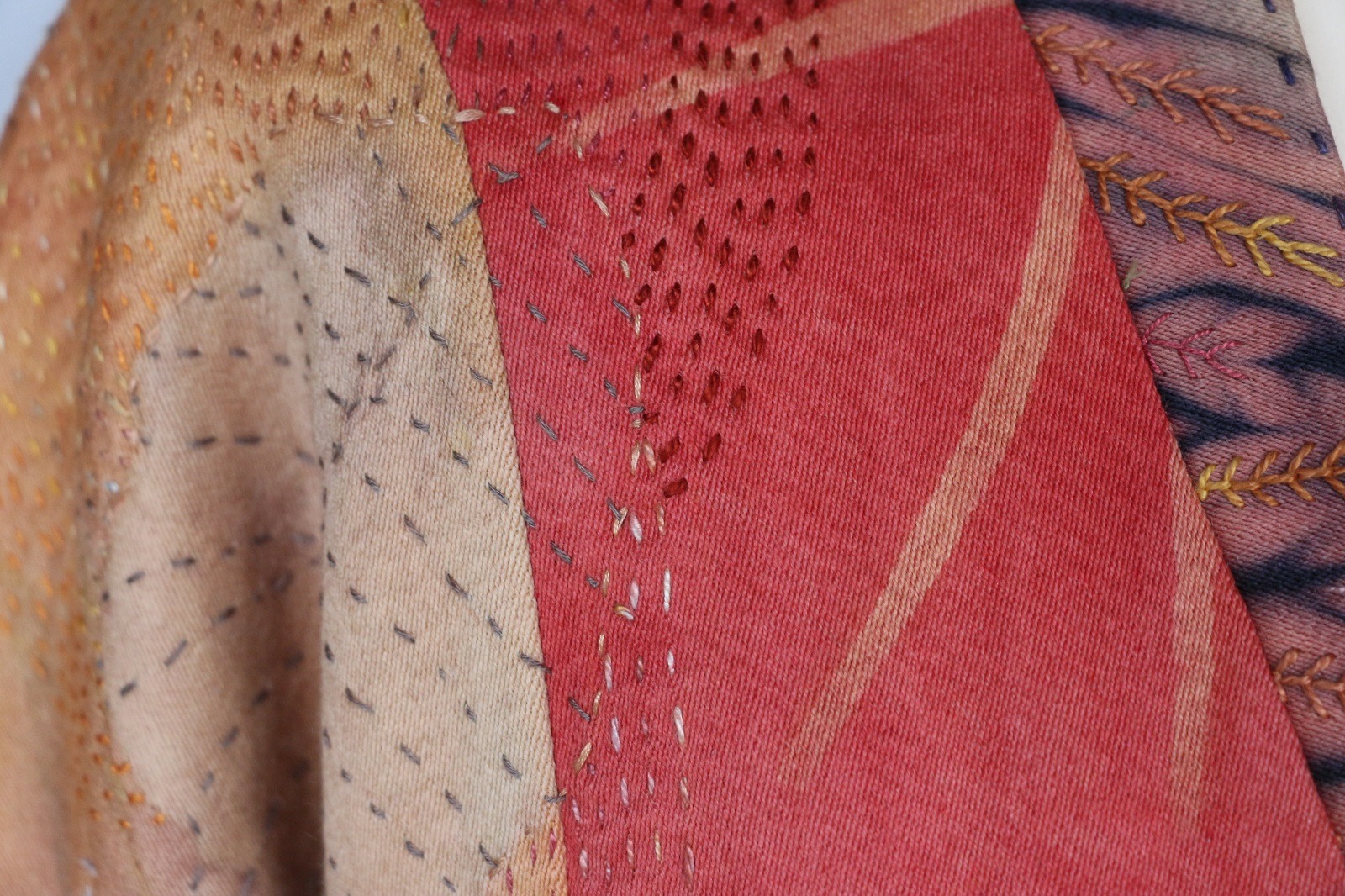
Room to explore
Tell us about some of your work that holds fond memories…
The first would be my opera coat. I found a wonderful piece of vintage wool/silk. I suspect it was intended for upholstery, but it was the perfect weight for a coat.
It was such lovely fabric that I auditioned many ideas before eventually deciding I would make a coat, incorporating all the techniques I knew. It really gave me scope to play with dye, shibori, print and stitch.
I wore it for the first time to the opera, hence the name. It was my first-ever entry to the Festival of Quilts, and it won a prize and became one of my proudest achievements.
The second is Les brodeuses Inconnues – The Unknown Embroideresses. When rummaging in French flea markets, I search for vintage textiles and big old pots in which to simmer my dyes. The household textiles I unearth often have beautiful embroidery and monograms that I find very poignant. Who was she, the lady who stitched this so exquisitely?
As an homage to them all, I pieced together a background of vintage embroidery, lace and monograms. I eco printed this with plants from the French hedgerows, integrated it with hand stitch, and added image transfers of ladies from old French photographs. I only have to glance at it to be transported right back to the France I love.
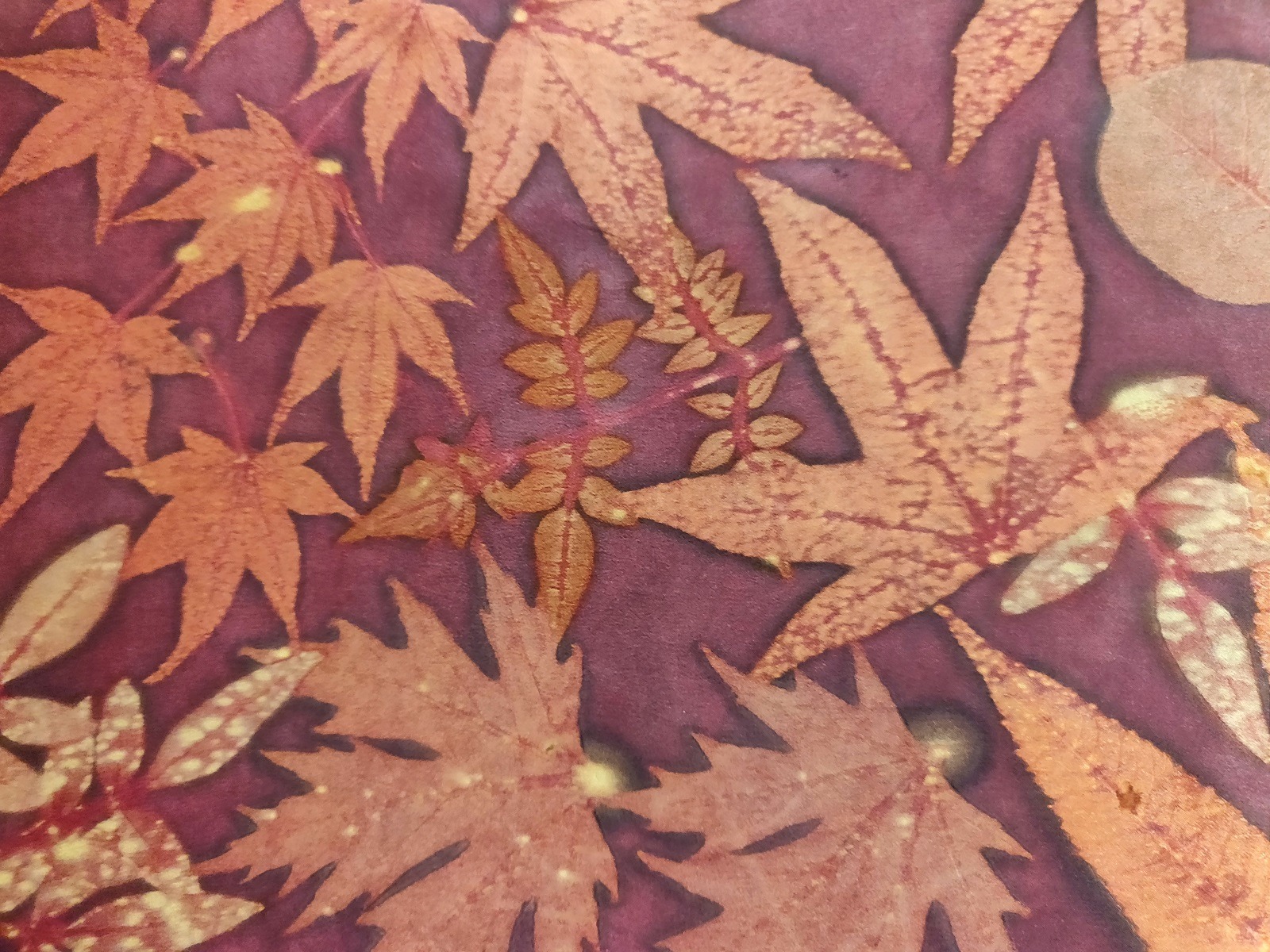
How has your work developed and how do you see it evolving in the future?
Though natural dyeing has a long history and comprehensive knowledge base, eco printing is a relatively new art form. There are many unknowns, so I am always experimenting, asking myself: ‘What if…?’ My work evolves as I discover new and exciting interactions between leaves, dyes and fabrics.
Due to these discoveries, when I look back at my work, I am surprised by how much I have extended my colour palette, composition and range of techniques. Nature is so full of wonderful surprises, I feel sure these discoveries will go on and on.
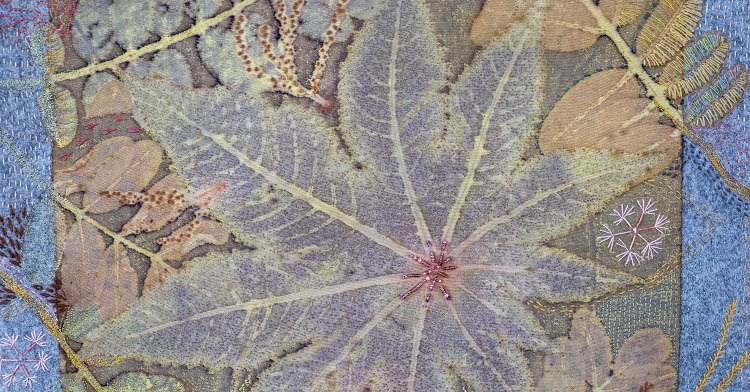
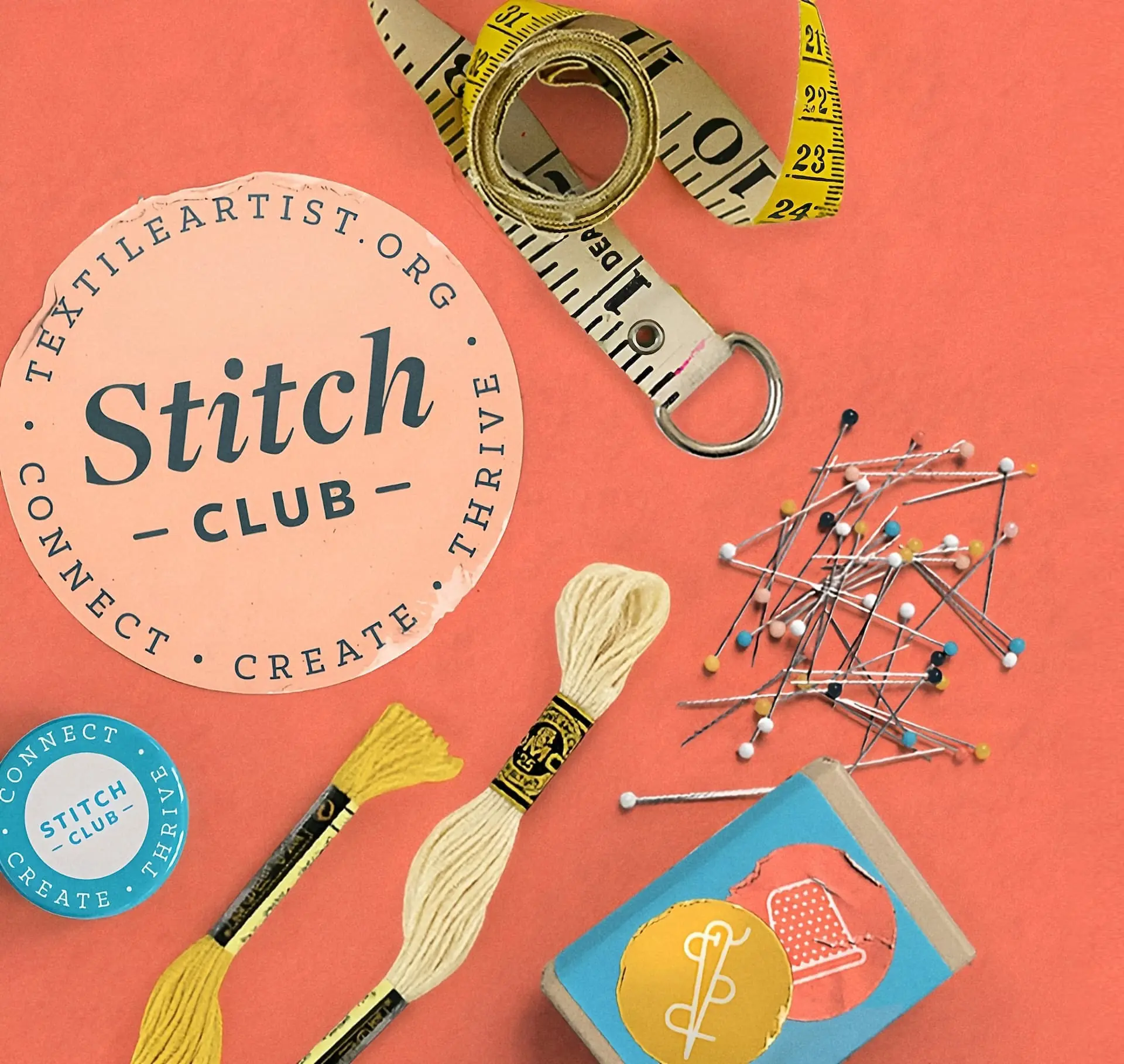
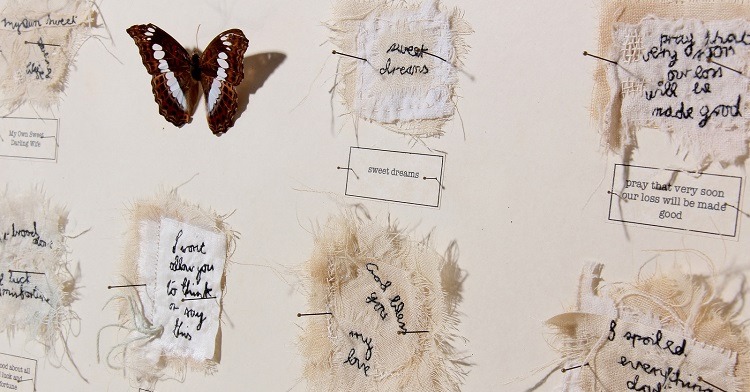
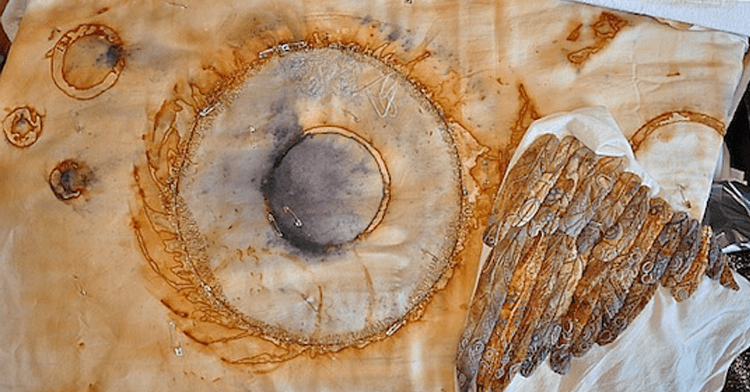
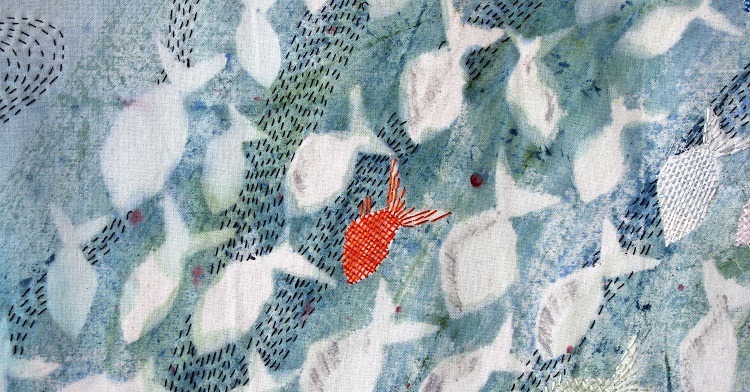
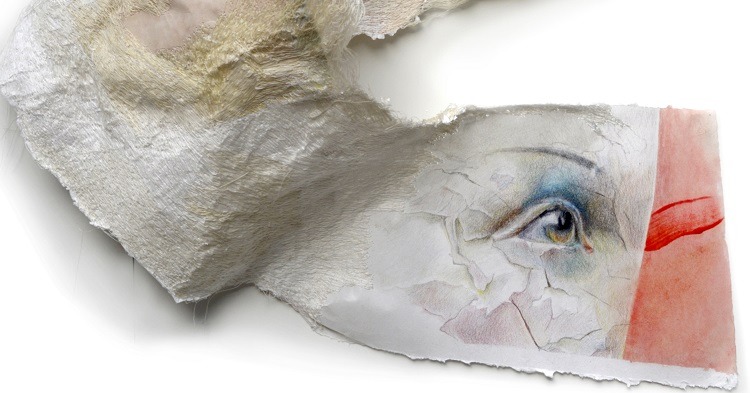
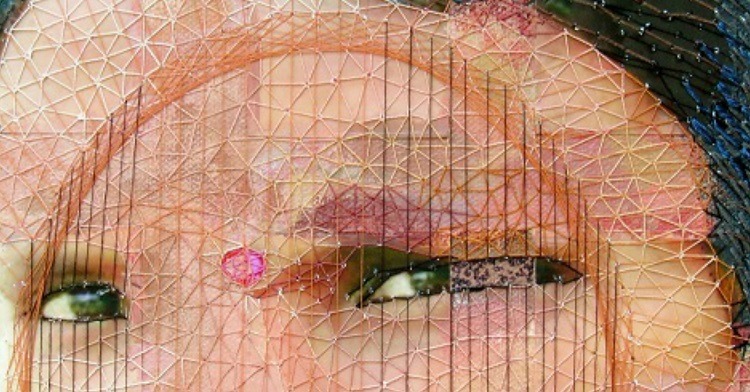
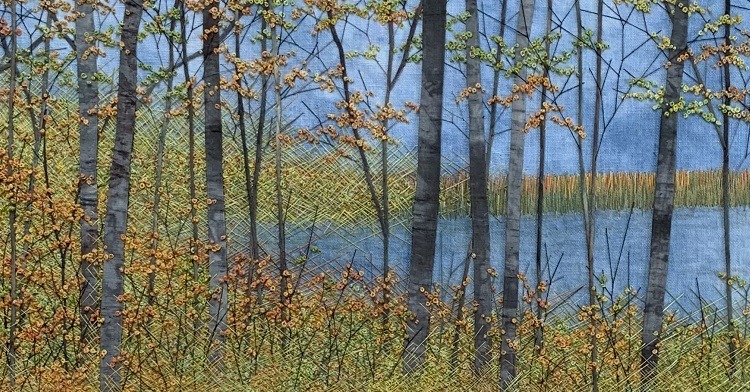
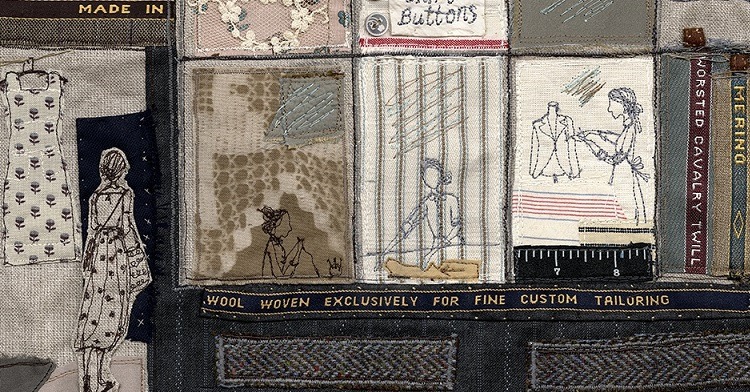
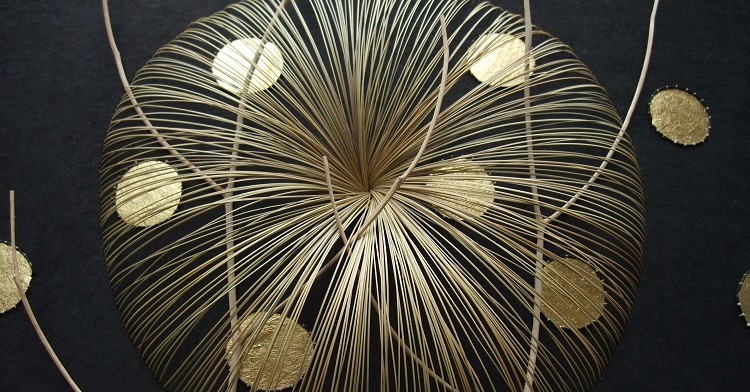
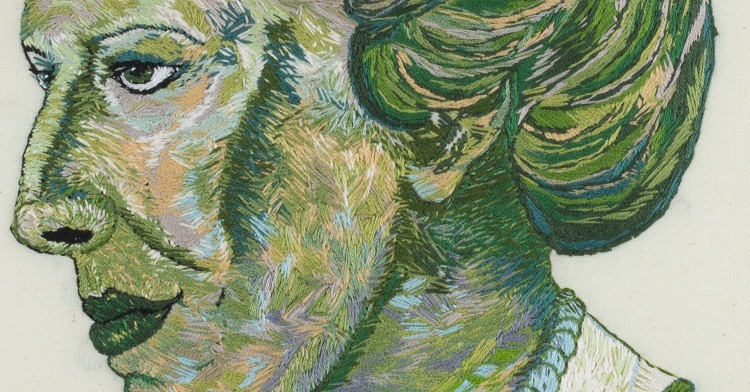
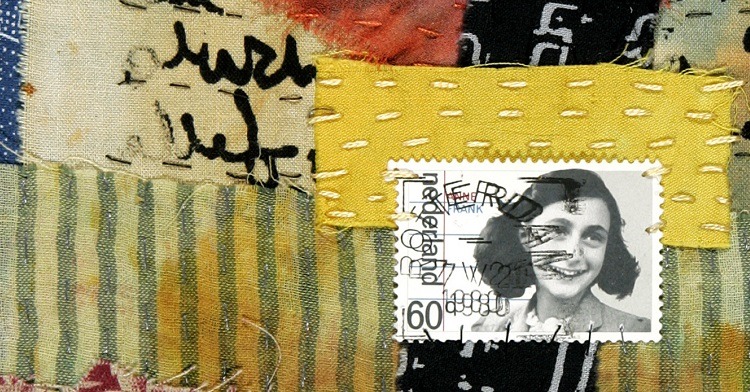
20 comments
Maryjo Griffin
Inspiring work! Really speaks to me – to try a small piece where I can use my love of garden, stitching, and foraging. Thanks for the inspiration!
Annie DUPEUX-AUBIER
J’ai lu avec beaucoup d’intérêt votre démarche qui fait écho en moi. Je suis patchworkeuse et brodeuse, et je commence à faire des expériences de couleurs végétales avec les fleurs, feuilles martelées sur de vieux tissus en coton que j’ai préparé avec de l’alun et des cristaux de soude. Je ne sais pas si les couleurs obtenues vont tenir dans le temps ? Mais j’adore les surprises des couleurs. Je commence à rebroder leurs traces sur le tissu.
J’aimerais avoir plus de détails sur la possibilité de suivre vos cours depuis la France. Merci. Cordialement,
Annie
Karen Selk
Congratulations Caroline on this lovely article. I have followed you in the Botanical Prints group and it was inspiring to hear a little more of your story. I am hopeful we will meet some day through a workshop. You are an inspiration, keep up your great work.
Carolyn Neville
An inspiring and informative interview – I really enjoyed reading it. I love botanical printing and have had great fun learning the techniques as well as experimenting!
I am yet to stitch on my printed fabrics – what stitches would you recommend to get me started please Caroline?
Michal
What a lovely interview! Caroline is truly inspiring!
Helen Anne Brown
I love this article. Caroline’s courses is exactly what I was looking for, though I didn’t know it until I read your article. Thank you so much. I have now signed up for one of her courses.
Caroline Nixon
looking forward to working with you Helen
Sue March
Thank you. A very inspiring interview. I have been following the development of Eco Printing for the last few years. I had a try during my C & G diploma course but did not pursue it but this has inspired me to have another go. I have the linen sheets, a spare fish kettle and a very large garden, so no excuses not to start now.
Caroline Nixon
sounds like you have everything you need- go for it!
Jennifer Richardson
Would Caroline consider another source for Carmine? 70’000 Female bugs are used to produce a pound weight of cochineal, as I understand it.
I’m trying boiled beetroot water, as a vegan the insects are not an option.
Has any eco dyer discovered a satisfactory substitute? Thank you.
Caroline Nixon
as a vegan I can understand your concern. The cochineal I use is farmed, and provides a living for impoverished women. I can’t really think of a natural vegetable rquivalent. unfortunately beetroot, red cabbage etc are fugitive, ie they fade away
Nilda Frenkiel
Bueno al final, muchas tendremos que reconocer lo positivo que tiene el Covid 19 uqe nos permite experimentar cosas nuevas en temas que a cada una interesa. En este caso Arte Textil y pude tomarme el tiempo para leer lo que la
Dra. Caroline Nixon nos cuenta en su artículo con gran lujo de detalles como y dónde busca las tela y demás implementos. Por todo lo que nos cuenta es admirable como persona porque no todas lo hacen.
Sinceramente me gustaría que le hagan llegar mis sinceras felicitaciones no sólo por sus trabajos tan bien y bonitos
realizados sino también por su gran y tan bien explicado artículo que despertó en mi ganas de “hacer algo”!!!!
Saludos a Joe & Sam y para ustedes también
Barbara Bexley
What an interesting article with so much to consider. Thank you Caroline for so generously sharing your techniques. With the likelihood of covid restrictions lasting through the Spring and thus extra time to play, I shall certainly look into this more and give it a go when the weather warms up a bit. Thank you again.
Kay Darwin
Loved reading about this lady. I remember being taught to sew by my grandmother and loved her button tin too. Inspiring to hear that this lady found another path to follow after illness meant she could no longer follow her original career choice.
Gloria
Love the idea of using vintage fabric .
Gill Sargeant
What an interesting article. I really enjoyed reading about Caroline Nixon’s approach to her art, she is very inspiring.
I am at the beginning of my textile journey, at the grand age of 58, and am researching all the different methods of fabric dyeing. The methods Caroline uses appeal very much to me and I look forward to finding out more about this technique. I enjoy working with all things silk, creating wonderful pictures and now I am yearning to create my ‘own’ colour palette for my work.
Thankyou for such an interesting article.
Elsa Buch
Thank you for your interesting article,it has inspired me to get back to working with textiles again. I used to enjoy and relax doing all sorts of dyeing fabrics and stitch into them, but have had a complete block for the last two years due fo my husband being very ill, I am hopeful I will get back to if again starting with some simple hand embroidery on some beautiful old vintage fabrics.
Caroline Nixon
so sorry about your hubby. life events can throw us right off track. start with a tiny project- sewing can be so soothing!
Angela
Such a wonderful inspiring piece! Thank you!
Is it possible to know how to set the natural dyes? Or is that a simplistic question?
Angela
Caroline Nixon
Unlike some synthetic dyes, natural dyes do not require setting after use. The setting takes place during the dyeing and ecoprinting process due to moisture and steam, often aided by a mordant, which is a metal salt that helps the pigment bind to the cloth